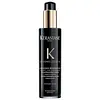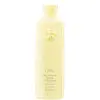What's inside
What's inside
 Key Ingredients
Key Ingredients

 Benefits
Benefits

 Concerns
Concerns

 Ingredients Side-by-side
Ingredients Side-by-side

Water
Skin ConditioningCera Alba
EmollientBeeswax
Emulsion StabilisingDimethicone
EmollientIsopropyl Myristate
EmollientPhenoxyethanol
PreservativeHydroxypropyl Guar
Emulsion StabilisingPEG-40 Hydrogenated Castor Oil
EmulsifyingTriethanolamine
BufferingHydroxyethylcellulose
Emulsion StabilisingCaprylyl Glycol
EmollientDimethiconol
EmollientPEG-30 Glyceryl Stearate
EmulsifyingHydrogenated Styrene/Butadiene Copolymer
Ethylhexylglycerin
Skin ConditioningBenzyl Salicylate
PerfumingHexyl Cinnamal
PerfumingAcrylates/C10-30 Alkyl Acrylate Crosspolymer
Emulsion StabilisingBenzyl Alcohol
PerfumingDisodium Stearoyl Glutamate
CleansingLimonene
PerfumingCitronellol
PerfumingTocopherol
AntioxidantBisabolol
MaskingSodium Hyaluronate
HumectantSafflower Glucoside
Geraniol
PerfumingHydroxycitronellal
PerfumingCoumarin
PerfumingButylene Glycol
HumectantPEG-30 Dipolyhydroxystearate
EmulsifyingTrideceth-6
EmulsifyingLinalool
PerfumingFarnesol
PerfumingAlteromonas Ferment Extract
Skin ConditioningSodium Citrate
BufferingParfum
MaskingWater, Cera Alba, Beeswax, Dimethicone, Isopropyl Myristate, Phenoxyethanol, Hydroxypropyl Guar, PEG-40 Hydrogenated Castor Oil, Triethanolamine, Hydroxyethylcellulose, Caprylyl Glycol, Dimethiconol, PEG-30 Glyceryl Stearate, Hydrogenated Styrene/Butadiene Copolymer, Ethylhexylglycerin, Benzyl Salicylate, Hexyl Cinnamal, Acrylates/C10-30 Alkyl Acrylate Crosspolymer, Benzyl Alcohol, Disodium Stearoyl Glutamate, Limonene, Citronellol, Tocopherol, Bisabolol, Sodium Hyaluronate, Safflower Glucoside, Geraniol, Hydroxycitronellal, Coumarin, Butylene Glycol, PEG-30 Dipolyhydroxystearate, Trideceth-6, Linalool, Farnesol, Alteromonas Ferment Extract, Sodium Citrate, Parfum
Water
Skin ConditioningPentylene Glycol
Skin ConditioningDimethicone
EmollientSalvia Hispanica Seed Extract
EmollientPPG-3 Benzyl Ether Myristate
EmollientCetyl Alcohol
EmollientDimethiconol Meadowfoamate
EmollientBrassica Alcohol
EmollientParfum
MaskingPolyquaternium-37
Guar Hydroxypropyltrimonium Chloride
Skin ConditioningBehentrimonium Chloride
PreservativeCaprylyl Methicone
Skin ConditioningBenzyl Alcohol
PerfumingBrassicyl Valinate Esylate
EmollientGlycerin
HumectantPanthenol
Skin ConditioningChlorphenesin
AntimicrobialSodium Benzoate
MaskingCalcium Gluconate
HumectantTrehalose
HumectantXylitol
HumectantButylene Glycol
HumectantHydrolyzed Rice Protein
Skin ConditioningCitric Acid
BufferingPolyquaternium-73
Caprylyl/Capryl Glucoside
CleansingIsopropyl Alcohol
SolventOryza Sativa Bran Extract
Skin ConditioningPanthenyl Hydroxypropyl Steardimonium Chloride
Quaternium-95
UV AbsorberTetrasodium Glutamate Diacetate
Ethyl Linoleate
EmollientCeramide NP
Skin ConditioningEthyl Oleate
EmollientSorbitan Oleate
EmulsifyingLeuconostoc/Radish Root Ferment Filtrate
AntimicrobialSodium PCA
HumectantCinnamidopropyltrimonium Chloride
Arctium Lappa Root Extract
Skin ConditioningHedera Helix Extract
AntimicrobialSodium Lactate
BufferingTrigonella Foenum-Graecum Seed Extract
PerfumingPropanediol
SolventSodium Phosphate
BufferingLactobacillus/Arundinaria Gigantea Leaf Ferment Filtrate
Skin ConditioningArginine
MaskingHelianthus Annuus Extract
EmollientAspartic Acid
MaskingPCA
HumectantLitchi Chinensis Fruit Extract
Skin ConditioningCitrullus Lanatus Seed Oil
EmollientPhenoxyethanol
PreservativeCaprylic Acid
CleansingGalactoarabinan
Tocopherol
AntioxidantRosmarinus Officinalis Leaf Extract
AntimicrobialLeontopodium Alpinum Extract
Skin ConditioningHydrolyzed Vegetable Protein Pg-Propyl Silanetriol
Skin ConditioningGlycine
BufferingAlanine
MaskingPotassium Sorbate
PreservativeSodium Acetylated Hyaluronate
HumectantCamellia Sinensis Leaf Extract
AntimicrobialSodium Hyaluronate
HumectantSerine
MaskingValine
MaskingEthylhexylglycerin
Skin ConditioningGossypium Herbaceum Seed Extract
Skin ConditioningPentaerythrityl Tetra-Di-T-Butyl Hydroxyhydrocinnamate
AntioxidantSodium Hyaluronate Crosspolymer
HumectantSodium Hydroxide
BufferingIsoleucine
Skin ConditioningProline
Skin ConditioningThreonine
Nigella Sativa Seed Extract
PerfumingHydrolyzed Sodium Hyaluronate
Skin ConditioningHistidine
HumectantPhenylalanine
MaskingCaprylyl Glycol
EmollientDisodium EDTA
Potassium Hydroxide
BufferingLimonene
PerfumingHexyl Cinnamal
PerfumingCitral
PerfumingLinalool
PerfumingWater, Pentylene Glycol, Dimethicone, Salvia Hispanica Seed Extract, PPG-3 Benzyl Ether Myristate, Cetyl Alcohol, Dimethiconol Meadowfoamate, Brassica Alcohol, Parfum, Polyquaternium-37, Guar Hydroxypropyltrimonium Chloride, Behentrimonium Chloride, Caprylyl Methicone, Benzyl Alcohol, Brassicyl Valinate Esylate, Glycerin, Panthenol, Chlorphenesin, Sodium Benzoate, Calcium Gluconate, Trehalose, Xylitol, Butylene Glycol, Hydrolyzed Rice Protein, Citric Acid, Polyquaternium-73, Caprylyl/Capryl Glucoside, Isopropyl Alcohol, Oryza Sativa Bran Extract, Panthenyl Hydroxypropyl Steardimonium Chloride, Quaternium-95, Tetrasodium Glutamate Diacetate, Ethyl Linoleate, Ceramide NP, Ethyl Oleate, Sorbitan Oleate, Leuconostoc/Radish Root Ferment Filtrate, Sodium PCA, Cinnamidopropyltrimonium Chloride, Arctium Lappa Root Extract, Hedera Helix Extract, Sodium Lactate, Trigonella Foenum-Graecum Seed Extract, Propanediol, Sodium Phosphate, Lactobacillus/Arundinaria Gigantea Leaf Ferment Filtrate, Arginine, Helianthus Annuus Extract, Aspartic Acid, PCA, Litchi Chinensis Fruit Extract, Citrullus Lanatus Seed Oil, Phenoxyethanol, Caprylic Acid, Galactoarabinan, Tocopherol, Rosmarinus Officinalis Leaf Extract, Leontopodium Alpinum Extract, Hydrolyzed Vegetable Protein Pg-Propyl Silanetriol, Glycine, Alanine, Potassium Sorbate, Sodium Acetylated Hyaluronate, Camellia Sinensis Leaf Extract, Sodium Hyaluronate, Serine, Valine, Ethylhexylglycerin, Gossypium Herbaceum Seed Extract, Pentaerythrityl Tetra-Di-T-Butyl Hydroxyhydrocinnamate, Sodium Hyaluronate Crosspolymer, Sodium Hydroxide, Isoleucine, Proline, Threonine, Nigella Sativa Seed Extract, Hydrolyzed Sodium Hyaluronate, Histidine, Phenylalanine, Caprylyl Glycol, Disodium EDTA, Potassium Hydroxide, Limonene, Hexyl Cinnamal, Citral, Linalool
Ingredients Explained
These ingredients are found in both products.
Ingredients higher up in an ingredient list are typically present in a larger amount.
Benzyl Alcohol is most commonly used as a preservative. It also has a subtle, sweet smell. Small amounts of Benzyl Alcohol is not irritating and safe to use in skincare products. Most Benzyl Alcohol is derived from fruits such as apricots.
Benzyl Alcohol has both antibacterial and antioxidant properties. These properties help lengthen the shelf life of products. Benzyl Alcohol is a solvent and helps dissolve other ingredients. It can also improve the texture and spreadability.
Alcohol comes in many different forms. Different types of alcohol will have different effects on skin. This ingredient is an astringent alcohol.
Using high concentrations of these alcohols are drying on the skin. They may strip away your skin's natural oils and even damage your skin barrier. Astringent alcohols may also irritate skin.
Other types of astringent alcohols include:
According to the National Rosacea Society based in the US, you should be mindful of products with these alcohols in the top half of ingredients.
Any type of sanitizing product will have high amounts of alcohol to help kill bacteria and viruses.
Learn more about Benzyl AlcoholButylene Glycol (or BG) is used within cosmetic products for a few different reasons:
Overall, Butylene Glycol is a safe and well-rounded ingredient that works well with other ingredients.
Though this ingredient works well with most skin types, some people with sensitive skin may experience a reaction such as allergic rashes, closed comedones, or itchiness.
Learn more about Butylene GlycolCaprylyl Glycol is a humectant and emollient, meaning it attracts and preserves moisture.
It is a common ingredient in many products, especially those designed to hydrate skin. The primary benefits are retaining moisture, skin softening, and promoting a healthy skin barrier.
Though Caprylyl Glycol is an alcohol derived from fatty acids, it is not the kind that can dry out skin.
This ingredient is also used as a preservative to extend the life of products. It has slight antimicrobial properties.
Learn more about Caprylyl GlycolDimethicone is a type of synthetic silicone created from natural materials such as quartz.
What it does:
Dimethicone comes in different viscosities:
Depending on the viscosity, dimethicone has different properties.
Ingredients lists don't always show which type is used, so we recommend reaching out to the brand if you have questions about the viscosity.
This ingredient is unlikely to cause irritation because it does not get absorbed into skin. However, people with silicone allergies should be careful about using this ingredient.
Note: Dimethicone may contribute to pilling. This is because it is not oil or water soluble, so pilling may occur when layered with products. When mixed with heavy oils in a formula, the outcome is also quite greasy.
Learn more about DimethiconeEthylhexylglycerin (we can't pronounce this either) is commonly used as a preservative and skin softener. It is derived from glyceryl.
You might see Ethylhexylglycerin often paired with other preservatives such as phenoxyethanol. Ethylhexylglycerin has been found to increase the effectiveness of these other preservatives.
Hexyl Cinnamal is a fragrance ingredient with a similar scent to jasmine. It can be naturally found in chamomile essential oil.
This ingredient is a known EU allergen and may sensitize the skin. The EU requires this ingredient to be listed separately on an ingredients list.
Hexyl Cinnamal is not water soluble but is soluble in oils.
Learn more about Hexyl CinnamalLimonene is a fragrance that adds scent and taste to a formulation.
It's found in the peel oil of citrus fruits and other plants such as lavender and eucalyptus. The scent of limonene is generally described as "sweet citrus".
Limonene acts as an antioxidant, meaning it helps neutralize free radicals.
When exposed to air, oxidized limonene may sensitize the skin. Because of this, limonene is often avoided by people with sensitive skin.
The term 'fragrance' is not regulated in many countries. In many cases, it is up to the brand to define this term. For instance, many brands choose to label themselves as "fragrance-free" because they are not using synthetic fragrances. However, their products may still contain ingredients such as essential oils that are considered a fragrance.
Learn more about LimoneneLinalool is a fragrance and helps add scent to products. It's derived from common plants such as cinnamon, mint, citrus, and lavender.
Like Limonene, this ingredient oxidizes when exposed to air. Oxidized linalool can cause allergies and skin sensitivity.
This ingredient has a scent that is floral, spicy tropical, and citrus-like.
Learn more about LinaloolParfum is a catch-all term for an ingredient or more that is used to give a scent to products.
Also called "fragrance", this ingredient can be a blend of hundreds of chemicals or plant oils. This means every product with "fragrance" or "parfum" in the ingredients list is a different mixture.
For instance, Habanolide is a proprietary trade name for a specific aroma chemical. When used as a fragrance ingredient in cosmetics, most aroma chemicals fall under the broad labeling category of “FRAGRANCE” or “PARFUM” according to EU and US regulations.
The term 'parfum' or 'fragrance' is not regulated in many countries. In many cases, it is up to the brand to define this term.
For instance, many brands choose to label themselves as "fragrance-free" because they are not using synthetic fragrances. However, their products may still contain ingredients such as essential oils that are considered a fragrance by INCI standards.
One example is Calendula flower extract. Calendula is an essential oil that still imparts a scent or 'fragrance'.
Depending on the blend, the ingredients in the mixture can cause allergies and sensitivities on the skin. Some ingredients that are known EU allergens include linalool and citronellol.
Parfum can also be used to mask or cover an unpleasant scent.
The bottom line is: not all fragrances/parfum/ingredients are created equally. If you are worried about fragrances, we recommend taking a closer look at an ingredient. And of course, we always recommend speaking with a professional.
Learn more about ParfumPhenoxyethanol is a preservative that has germicide, antimicrobial, and aromatic properties. Studies show that phenoxyethanol can prevent microbial growth. By itself, it has a scent that is similar to that of a rose.
It's often used in formulations along with Caprylyl Glycol to preserve the shelf life of products.
Sodium Hyaluronate is hyaluronic acid's salt form. It is commonly derived from the sodium salt of hyaluronic acid.
Like hyaluronic acid, it is great at holding water and acts as a humectant. This makes it a great skin hydrating ingredient.
Sodium Hyaluronate is naturally occurring in our bodies and is mostly found in eye fluid and joints.
These are some other common types of Hyaluronic Acid:
Learn more about Sodium HyaluronateTocopherol (also known as Vitamin E) is a common antioxidant used to help protect the skin from free-radicals and strengthen the skin barrier. It's also fat soluble - this means our skin is great at absorbing it.
Vitamin E also helps keep your natural skin lipids healthy. Your lipid skin barrier naturally consists of lipids, ceramides, and fatty acids. Vitamin E offers extra protection for your skin’s lipid barrier, keeping your skin healthy and nourished.
Another benefit is a bit of UV protection. Vitamin E helps reduce the damage caused by UVB rays. (It should not replace your sunscreen). Combining it with Vitamin C can decrease sunburned cells and hyperpigmentation after UV exposure.
You might have noticed Vitamin E + C often paired together. This is because it is great at stabilizing Vitamin C. Using the two together helps increase the effectiveness of both ingredients.
There are often claims that Vitamin E can reduce/prevent scarring, but these claims haven't been confirmed by scientific research.
Learn more about TocopherolWater. It's the most common cosmetic ingredient of all. You'll usually see it at the top of ingredient lists, meaning that it makes up the largest part of the product.
So why is it so popular? Water most often acts as a solvent - this means that it helps dissolve other ingredients into the formulation.
You'll also recognize water as that liquid we all need to stay alive. If you see this, drink a glass of water. Stay hydrated!
Learn more about Water